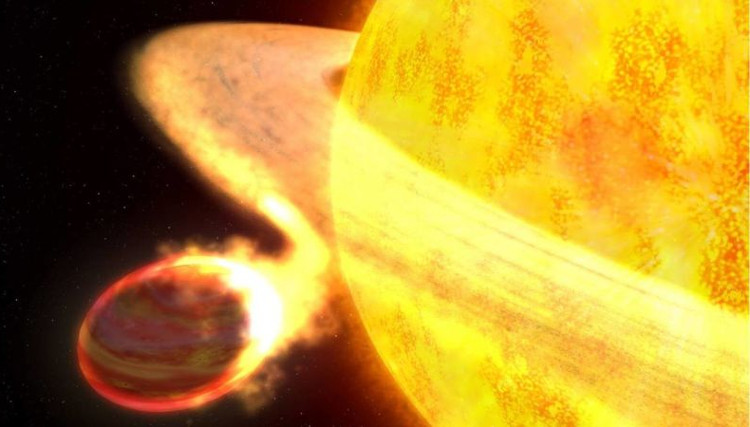Stars change color when swallowing the planet
The stars may turn pink when swallowing an iron-rich planet, similar to the pink-feathered crane birds that eat a lot of shrimp.
According to IFL Science, in 2015, scientists hypothesized that a large amount of iron found on a young star in the cluster of Gamma Velorum could be caused by the star swallowing an iron-rich planet. The theory is strengthened when researchers find many other elements, which exist in cosmic rocks that exist around this star.
In a statement published on arXiv on May 25, a team of researchers at the University of Pisa, Italy simulated what could happen when a planet or large object was swallowed up by a young star similar to in Gamma Velorum star cluster.

A planet is being swallowed up by the star near it.(Photo: NASA).
"From now on, we have no detailed data on the accretion process and cannot observe directly from the telescope , " the study author said. "This result is the first study of the main impact of the process that takes place when a star swallows the planet around."
The young star is relatively small, has a mass of 1.2 to 1.3 Sun, and just swallowing 1 or 2 planets is a significant change in chemical composition. However, this depends on the age of the star.
The scientists' model shows that in order to have a high iron content as in the young stars of the Gamma Velorum cluster, the star must swallow 53 Earth-like planets if under 10 million years old. After 15 million years of age, stars need only two Earth-sized planets are enough to undergo major changes.
The increased amount of metallic elements helps the star absorb the short-wavelength radiation better, and we will see it redder. The red or pink color of the star depends on the amount of metal it absorbs.
Researchers point out that any star is capable of swallowing the planet. In the early days of its formation, the Sun had swallowed up a few planets around it.
- The color of the shell changes color to the body
- Finding the swallowing star 'neighbor'
- Screen development is based on the color change of ink
- Black hole woke up after 30 years,
- Why do people swallow swords?
- Paintings change color like chameleon
- Discover a planet forming around two stars
- Will climate change change the color of autumn?
- After 20 seconds of laser projection, the eye color will change from brown to green permanently
- 12 signs of cancer in men
- Chameleons can change color blind?
- Frogs change color
 Van Allen's belt and evidence that the Apollo 11 mission to the Moon was myth
Van Allen's belt and evidence that the Apollo 11 mission to the Moon was myth The levels of civilization in the universe (Kardashev scale)
The levels of civilization in the universe (Kardashev scale) Today Mars, the sun and the Earth are aligned
Today Mars, the sun and the Earth are aligned The Amazon owner announced a secret plan to build a space base for thousands of people
The Amazon owner announced a secret plan to build a space base for thousands of people